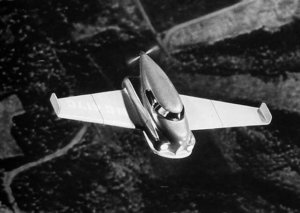Flying car
|
|
It wasn't long after the Wright Brothers made their first successful flight that aviation pioneers began to imagine a hybrid aircraft/automobile. A flying car would be a vehicle for the common man. It could be driven from any home to a convenient take-off area where it could be assembled for flight.
| Contents |
Early experiments
Glenn Curtiss, the Wright's chief rival, was the first to design a flying car. The Autoplane had three wings and an aluminum body, using the same wings as his Model L Triplane which spanned 40 feet. The assembled length was 20 feet, the body/fuselage using a twin boom rear section with the engine mounted between the booms. The Autoplane never flew but was exhibited at the Pan-American Aeronautic Exposition in New York City's Grand Central Palace in February 1917. The first patent awarded for a flying car went to F. Longobardi in 1918 and Curtiss received a patent for the Autoplane in 1919.
The first flying car to actually fly was built by Waldo Waterman. Waterman became associated with Curtiss while Curtiss was pioneering naval aviation at North Island on San Diego Bay in the 1910s. However, it wasn't until February 21 1937 that Waterman's Arrowbile first took to the air. The Arrowbile was a development of Waterman's tailless airplane, the Whatsit. It had a wingspan of 38 feet and a length of 20 feet 6 inches. On the ground and in the air it was powered by a Studebaker engine. It could fly at 110 MPH and drive at 55 MPH. Five Arrowbiles were completed and two were flown from Santa Monica, California to Cleveland, Ohio for demonstration flights during air races. Waterman restored Arrowbile No. 6 (No. 5 was never completed) in the 1960s and donated it to the Smithsonian Institution, where it is in storage. Arrowbile No. 4 is reported to still exist in non-working condition.
Post-war development
In the 1950s, the western world was recovering from World War II and everything seemed possible. The flying car was a vision of transportation in the 21st century, and a common feature of science fiction futures.
Several designs exist (such as Moller's skycar) and while several (such as the Convair flying car and Molt Taylor's Aircar) have flown, none have enjoyed commercial success and those that have flown are not widely known about by the general public. One notable design, Henry Smolinski's Mizar, made by mating the rear end of a Cessna Skymaster with a Ford Pinto, disintegrated during test flights, killing Smolinski and the pilot.
In the 1950s, Ford Motor Company performed a serious feasibility study for a flying car product. They concluded that such a product was technically feasible, economically manufacturable, and had significant realistic markets. The markets explored included ambulance services, police and emergency services, military uses, and initially, luxury transportation. Some of these markets are now served by light helicopters, proving the accuracy of Ford's marketing. However, the flying car explored by Ford would be at least fifty-fold less expensive.
When Ford approached the U.S. Federal Aviation Administration about regulatory issues, the critical problem was that the (then) known forms of air traffic control were inadequate for the volume of traffic Ford proposed. At the time, air traffic control consisted of flight numbers, altitudes and headings written on little slips of paper and placed in a case. Quite possibly computerized traffic control, or some form of directional allocation by altitude could resolve the problems. However, between intoxicated drivers, the large number of motorists in certain places who never bother to earn a driver's license, and the significant number of severely impaired drivers, the actual introduction of flying cars would certainly lead to millions of midair collisions which would result in an untold amount of death and destruction.
As the successive decades since failed to deliver such a vehicle, the flying car became somewhat of a totem of the failure of futurology to accurately predict the future development of society and was regularly used to poke fun at futurists.
List of flying cars and roadable aircraft
- Curtiss Autoplane - 1917, never flown
- Waterman Arrowbile - 1937 two examles in museums as of 2004
- Aerocar Aerocar - 1949, one example still flying as of 2004
- Aerauto PL.5C - early 1950s
- AVE Mizar - 1973, Cesna Skymaster/Ford Pinto hybrid. Crashed, killing developer.
- Moller Skycar - 2003, small VTOL.
- CarterCopter - near VTOL aircraft
Fictional
The novels of Philip K. Dick and the film Blade Runner (the latter based on one of Dick's novels), in particular, feature VTOL flying cars, in the form of "flapples" and "spinners" respectively. More recently, flying cars have made the transition from science fiction to fantasy in the Harry Potter books, in the form of an otherwise-stock (and long since obsolete) Ford Anglia enchanted to fly.
One of the most iconic flying cars is the De Lorean from the film Back_to_the_Future_Part_II, which underwent "hover conversion" while time-travelling in the future.
The Flying Car was humorous skit written in 2002 for the Tonight Show by Kevin Smith. It starred Dante and Randall stuck in traffic, discussing the lengths one would go to obtain one.
In Calvin and Hobbes, the following discussion may be found (and appears to be the earliest known 'Where are the flying cars?'): "Hobbes: "A new decade is coming up." Calvin: "Yeah, big deal! Hmph. Where are the flying cars? Where are the moon colonies? Where are the personal robots and the zero gravity boot, uh? You call this a new decade?! You call this the future?? HA! Where are the rocket packs? Where are the disintegration rays? Where are the floating cities?"
See also Chitty Chitty Bang Bang, Transport, Automobile, future of the car
External links
- Flying car (http://www.volanteaircraft.com) (Volante Aircraft)
- Waterman Arrowbile at the Smithsonian (http://www.nasm.si.edu/research/aero/aircraft/waterman.htm)
- Flying cars in 25 years (http://news.bbc.co.uk/1/hi/sci/tech/3676694.stm) (BBC News Online)

